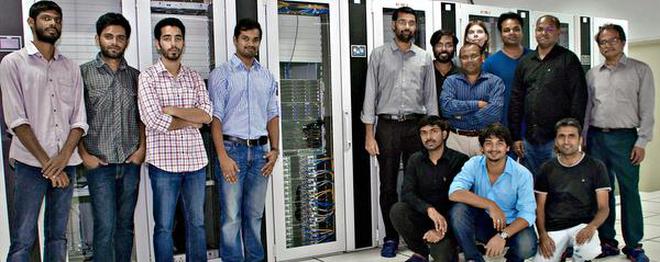It is always good to be part of the winning team!
Nobel boost to Bengaluru’s link to LIGO
Mohit M Rao Bengaluru, October 05, 2017 23:07 IST
 Elated lot A team from Bengaluru-based International Centre for Theoretical Sciences has been deciphering data from Laser Interferometer Gravitational-wave Observatory. | Photo Credit: By Special Arrangement
Elated lot A team from Bengaluru-based International Centre for Theoretical Sciences has been deciphering data from Laser Interferometer Gravitational-wave Observatory. | Photo Credit: By Special Arrangement
City scientists play significant role in project pioneered by this year’s Nobel laureates
As Rainer Weiss, Barry C. Barish and Kip S. Thorne take the stage later this year to accept the Nobel Prize for Physics, they will be standing on the shoulders of hundreds of collaborators from across the world, who collectively made it possible to sense gravitational waves that “shook the world” in 2016.
Of these, more than 35 scientists from India, including a team of seven from Bengaluru-based International Centre for Theoretical Sciences (ICTS), played a significant role in understanding and deciphering the data from the Laser Interferometer Gravitational-wave Observatory (LIGO), an international collaboration pioneered by the three Nobel laureates.
At Hessarghatta, the seven-member team — led by Parameswaran Ajith from ICTS — works on modelling the sources of gravitational waves, among others; their LIGO Tier-3 grid computing centre tests Einstein’s famous Theory of Relativity with the data thrown up by the detectors in the U.S. and Europe. “The laureates associate themselves with the LIGO/Virgo collaboration rather than their individual academic institutions. They have even said the award would be received on behalf of the collaborators. It’s heartening to see this,” says Dr. Ajith.
The team, after all, finds a place amongst the thousand authors, including the three laureates, of the paper ‘Observation of Gravitational Waves from a Binary Black Hole Merger’, which announced the experimental proof of gravitational waves in 2016.
India and LIGO
Indian scientists have a long, often unacknowledged presence in the fledgling field. For instance, the works of C. V. Vishveshwara, who died in the city earlier this year, in the 1970s continues to remain highly relevant.
And, it is perhaps these initial forays that has seen India do better in this field of research than others. “A few decades ago, it was just two of us in gravitational waves,” says Bala Iyer, chairperson of IndIGO (Indian Initiative in Gravitational-wave Observations) consortium and also associated with ICTS. “Now, there is a community of over 200 and we are struggling to keep up with the interest.”
With the ₹1,500-crore Indian LIGO detector expected to be operational by 2024, India is expected to play a key role in utilising the discovery that many scientists say is bigger than X-ray or microwave radiation that gave unparalleled views of the universe.
http://www.thehindu.com/news/nation...al&utm_source=twitter.com&utm_campaign=buffer
Nobel boost to Bengaluru’s link to LIGO
Mohit M Rao Bengaluru, October 05, 2017 23:07 IST
City scientists play significant role in project pioneered by this year’s Nobel laureates
As Rainer Weiss, Barry C. Barish and Kip S. Thorne take the stage later this year to accept the Nobel Prize for Physics, they will be standing on the shoulders of hundreds of collaborators from across the world, who collectively made it possible to sense gravitational waves that “shook the world” in 2016.
Of these, more than 35 scientists from India, including a team of seven from Bengaluru-based International Centre for Theoretical Sciences (ICTS), played a significant role in understanding and deciphering the data from the Laser Interferometer Gravitational-wave Observatory (LIGO), an international collaboration pioneered by the three Nobel laureates.
At Hessarghatta, the seven-member team — led by Parameswaran Ajith from ICTS — works on modelling the sources of gravitational waves, among others; their LIGO Tier-3 grid computing centre tests Einstein’s famous Theory of Relativity with the data thrown up by the detectors in the U.S. and Europe. “The laureates associate themselves with the LIGO/Virgo collaboration rather than their individual academic institutions. They have even said the award would be received on behalf of the collaborators. It’s heartening to see this,” says Dr. Ajith.
The team, after all, finds a place amongst the thousand authors, including the three laureates, of the paper ‘Observation of Gravitational Waves from a Binary Black Hole Merger’, which announced the experimental proof of gravitational waves in 2016.
India and LIGO
Indian scientists have a long, often unacknowledged presence in the fledgling field. For instance, the works of C. V. Vishveshwara, who died in the city earlier this year, in the 1970s continues to remain highly relevant.
And, it is perhaps these initial forays that has seen India do better in this field of research than others. “A few decades ago, it was just two of us in gravitational waves,” says Bala Iyer, chairperson of IndIGO (Indian Initiative in Gravitational-wave Observations) consortium and also associated with ICTS. “Now, there is a community of over 200 and we are struggling to keep up with the interest.”
With the ₹1,500-crore Indian LIGO detector expected to be operational by 2024, India is expected to play a key role in utilising the discovery that many scientists say is bigger than X-ray or microwave radiation that gave unparalleled views of the universe.
http://www.thehindu.com/news/nation...al&utm_source=twitter.com&utm_campaign=buffer
Last edited:
